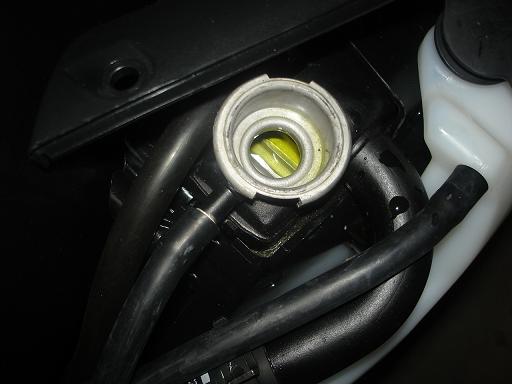| Author | Message | ||
Hooliagn |
What color is the antifreeze in your bike ? Mine is green but the Harley stuff is pink ???? | ||
Tasmaniac |
Mine is green too but i just topped it up with the pink, it's the only colour that H-D sell so it obviously cant hurt. Regards Brett | ||
Pariah |
The original antifreeze was yellow. The Harley stuff is pink. Wonder what the bike came with... brand, type? | ||
Hooliagn |
I thought you weren't supposed to mix the two colors or change from color to color ??? | ||
Xl1200r |
Yellow is the only color you can mix freely. Green is glycol based and pink has some organic compounds for corrosion resistance, and the two don't mix well. Green = standard glycol based coolant, can only mix with yellow Pink = organic compounds, brand name is DexCool, can only mix with yellow. Yellow = another organic but more tolerant and mix with anything. Brand name is G09, prestone calls of "big yellow". | ||
Rocketray |
Wow. Amazing what can be learned here on BadWeather. You guys are the best! Ray | ||
Sharkytattoo |
Pay no attention to the color. The factory has a different color than the jugs on our shelves is all. | ||
Mikellyjo |
I found this little tid bit on info while noodling around the web...take it with a grain of salt but it's good cannon fodder for sure. Conventional (usually green color) coolants are engineered to work well at a pH of 8.5 to 10.5. For decades, this technology has been effective and has provided good protection to the system's metals. The higher (alkaline) pH is important to these technologies because it improves the solubility of the conventional additives, and also maintains a generally less friendly environment to corrosion. When the coolant wears, the ethylene glycol breaks down a little forming acids, the pH drops and some of the components can oxidize. The coolant becomes worn out, so the recommendation and practice was to change the coolant every 2-3 years. This practice can still be followed with very satisfactory system performance. Extended service coolants can be subdivided into two categories: carboxylate and hybrid. The carboxylate (usually orange but sometimes yellow or blue) coolants generally operate at a pH between 6.0 and 8.5. At this pH, conventional inhibitors can be hard to keep in solution. The carboxylate inhibitors stay in solution and perform well in this pH range. The hybrid coolants contain benzoate, and may contain a variety of conventional style components. They operate a in a pH range of 7.5 to 8.5, interestingly positioned between the other two. Nevertheless, the stability of some additives has been a challenge that has been overcome by the scientists that formulate these technologies. Mixing some of these technologies with low pH carboxylates would seem problematic. ATA's Technology Maintenance Council (TMC) has recommended that mixing coolants be limited to 10% of a coolant. That is to say, mixing coolants is not recommended, and if more than 10% of the fluid is replaced the wrong technology, there is a question as to the capability of the coolant to prevent damage to the system. Amalgatech agrees; laboratory investigations strongly suggest that mixing coolants above 10% by volume with other coolant types seriously compromises corrosion protection in standard ASTM tests. (Message edited by mikellyjo on January 08, 2009) (Message edited by mikellyjo on January 08, 2009) | ||
Hooliagn |
In not so many words, that's what also heard a while back. | ||
Redscuell |
Mine is the pale yellow, as delivered a month ago. I like hearing that it's not ethylene glycol, because the local track suggests glycol not be used; but on the road the big disadvantage is that I CAN'T SEE IT IN THE OVERFLOW BOTTLE SIGHT HOLE because of the already-milky bottle plastic! So if I want to know the level, I have to take off the pod cover. PITA. | ||
Hooliagn |
Is this the color of your antifreeze ?  | ||
Pariah |
Red, you don't have to take off the pod. The secret is to use a flashlight... I have a 100 lumens led mini flashlight. Shine it into the pod so that it illuminates the overflow bottle itself. You will then see the indicator sight hole... it should be the pale yellow color. |